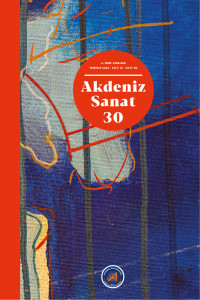İmparator Iustinianus’un İmar Programı Kapsamında Anadolu’da Hamamlar Ve Su Yapıları
Iustinianus, Prokopius, imar programı, hamamlar-su yapıları
Baths And Water Structures In Anatolia Within The Iustinian’s Building Program
___
- Arthur, P., Bizans ve Türk Dönemi’nde Hierapolis (Pamukkale), İstanbul, 2006.
- Berger, A., Das Bad in der byzantinischen Zeit, München, 1982.
- Berger, A., “Bizans Çağında Hamamlar”, Anadolu Medeniyetlerinde Hamam Kültürü: Mimari, Tarih ve İmgelem, (ed. N. Ergin), İstanbul, 2011. 67 – 83.
- Brödner, E., Die Römisschen Thermen und das Antike Badewesen, Darmstadt, 1983.
- Cameron, A., Prokopius and the Sixth Century, London, 1996.
- D’Andreia, F., Hierapolis of Phrygia (Pamukkale): an archaeological guide, İstanbul. 2003.
- Downey, G., Konstantinopolis in the Age of Justinian, Norman, 1960.
- Freeley, J., - Çakmak, A. S., İstanbul’un Bizans Anıtları, İstanbul, 2005.
- Gerkan A. - Krischen, F. Milet: Ergebnisse der Ausgrabungen und Untersuchungen seit dem
- Jahre 1899. Volume 1, fasc. 9: Thermen und Palaestren, Berlin, 1928.
- Gregory, T. E., Bizans Tarihi, (çev. Esra Ermert), İstanbul, 2011.
- Haldon, J. F., Byzantium in the seventh century, Cambridge, 2003.
- Ivison, E. A., “Excavations at the Lower City Enclosure, 1996– 2008”, Amorium Reports 3 - The
- Lower City Enclosure. Finds Reports and Technical Studies, (ed. C. Lightfoot – E.A. Ivison), İstanbul, 2012. 5 – 151.
- Kazhdan, A., “Prokopius of Caesarea”, Oxford Dictionary of Byzantium, Oxford. 1991.
- Kılavuz, B. N. - Çelikbaş, E. “Paphlagonia Hadrianoupolis’i”, Türk Kültürü ve Sanat Araştırmaları Dergisi, vol. 2, No. 3, 2013. 169 – 172.
- Levtchenko, M.L., Bizans Tarihi, (çev. Maide Selen), İstanbul. 2007,
- Maas, M., The Cambridge Companion to the Age of Iustinian, Cambridge, 2005.
- Mango, C., “Daily Life in Byzantium”, Jahrbuch der Österreichischen Byzantinischien Gesellschaft 31/1, 1981. 337 – 353.
- Mango, C., “La Vita in Citta”, (ed. A. Guillou), La Civilta Bizantina. Oggetti e Messaggio. Architettura e Ambiente di Vita, Rome, 1993. 229 – 273.
- Mango, C. Bizans Mimarisi, (çev. Mine Kadiroğlu), İstanbul, 2006.
- Moorhead, J., Justinian, London, 1994.
- Nielsen, I., Thermae et Balnea. The Architecture and Cultural History of Roman Public Baths, Aarhus, 1990.
- Norwich, J. J., Bizans. Erken Dönem (MS 323-802), (çev. Hamide Koyukan), İstanbul, 2013.
- Prokopius, De Aedificiis, (Kullanılan Metin ve Çeviri: Prokopius, Buildings. With an English Translation by H. B. Dewing with the collaboration of G. Downey, vol. VII), Cambridge, Mass London, 2002.
- Rapp, C., “Literary Culture under Iustinian” The Cambridge Companion to the Age of Iustinian, (ed. Michael Maas), Cambridge, 2005. 376-397.
- Roueché, C., Aphrodisias in Late Antiquity: The Late Roman and Byzantine Inscriptions, London, 2004.
- Russel, J., “Transformations in early Byzantine urban life. The contribution and limitations of archaeological evidence”, The 17th International Byzantine Congress, New Rochelle, 1986. 137 –154.
- Saradi, H. G., The Byzantine City in the Sixth Century: Literary Images and Historical Reality, Athens, 2006.
- Martens, F., “Private bathing and water consumption at Sagalassos (SW-Turkey) and Asia
- Minor”, (ed. C. Ohlig), Cura Aquarum in Jordania, Siegburg, 2008. 285 – 300.Yegül, F. K., “Cilicia at the Crossroads: Transformations of Baths and Bathing Culture in the Roman East”, Olba VIII, 2003. 55 – 73.
- Yegül, F. K., Antik Çag’da Hamamlar ve Yıkanma, Istanbul, 2006.
- Yegül, F. K., “The Baths of Constantinople: An Urban Symbol in a Changing World”, (ed. W. Caraher - L. J. Hall - R. S. Moore), Archaeology and History in Classical, Medieval and Post- Medieval Greece, Studies on Method and Meaning in Honor of Timothy E. Gregory, New York, 2008. 169 – 196.
- Yegül, F. K., Roma Dünyasında Yıkanma, Istanbul, 2011.
- Waelkens, M., et. al. The 1996 and 1997 Excavation Seasons at Sagalassos, Leuven, 2000: 336-362
- Wiplinger, G., “Ephesos Bizans Dönemi Su Yolları”, Bizans Dönemi’nde Ephesos, (ed. F. Daim –
- Zellinger, J., Bad und Bader in der Altchristlichen Kirche, Munich, 1928.
- ISSN: 1307-9700
- Yayın Aralığı: Yılda 2 Sayı
- Başlangıç: 2008
- Yayıncı: Akdeniz Üniversitesi
Elazığ Hazar Gölü Orta Çağ Batık Yerleşimi Arkeolojik Araştırması Sonuçları
Balkan Ülkelerinde Osmanlı Eserleri Üzerine İstatistiki Değerlendirme
Mehmet Zeki İBRAHİMGİL, Hamza KELEŞ
Kazakistan, Kızılorda İli Şiyeli İlçesinde Bulunan Okşı Ata Türbesi
Gulbanu KOSHENOVA, Yerlan ZHIYENBAYEV
İslam Sanatında Zikzak Deseni ve Anlamları Üzerine Bir Okuma
Oryantalist Bağlamda William Holman Hunt Üzerine Bir Değerlendirme
İmparator Iustinianus’un İmar Programı Kapsamında Anadolu’da Hamamlar Ve Su Yapıları
